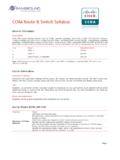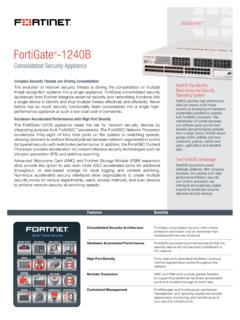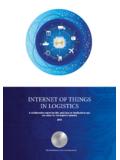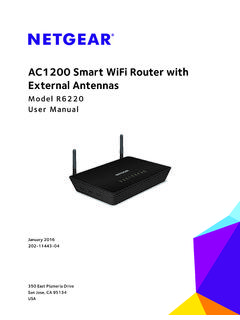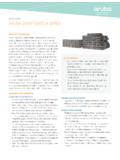Transcription of 6LoWPAN demystified - TI.com
1 6 LoWPAN demystifiedJonas OlssonSystem Applications Engineer Texas Instruments 6 LoWPAN demystified 2 October 2014 Introduction6 LoWPAN is connecting more things to the cloud. Low-power, IP-driven nodes and large mesh network support make this technology a great option for Internet of Things (IoT) applications. As the full name implies IPv6 over Low-Power Wireless Personal Area Networks 6 LoWPAN is a networking technology or adaptation layer that allows IPv6 packets to be carried efficiently within small link layer frames, such as those defined by IEEE The use of an end-to-end, IP-based infrastructure takes full advantage of 30+ years of IP technology development, facilitating open standards and interoperability as largely demonstrated through the daily use of the Internet and its almost 3 billion is an open standard defined in RFC 6282 by the Internet Engineering Task Force (IETF), the standards body that defines many of the open standards used on the Internet such as UDP, TCP and HTTP to name a few.
2 A powerful feature of 6 LoWPAN is that while originally conceived to support IEEE low-power wireless networks in the band, it is now being adapted and used over a variety of other networking media including Sub-1 GHz low-power RF, Bluetooth Smart, power line control (PLC) and low-power Wi-Fi .This white paper discusses key 6 LoWPAN concepts to demonstrate how it enables the use of IPv6 over IEEE radio network architectureFigure 1 on the following page shows an example of an IPv6 network, including a 6 LoWPAN mesh network. The uplink to the Internet is handled by the Access Point (AP) acting as an IPv6 router. Several different devices are connected to the AP in a typical setup, such as PCs, servers, etc. The 6 LoWPAN network is connected to the IPv6 network using an edge router. The edge router handles three actions: 1) the data exchange between 6 LoWPAN devices and the Internet (or other IPv6 network); 2) local data exchange between devices inside the 6 LoWPAN; and 3) the generation and maintenance of the radio subnet (the 6 LoWPAN network).
3 By communicating natively with IP, 6 LoWPAN networks are connected to other networks simply using IP routers. As shown in Figure 1, 6 LoWPAN networks will typically operate on the edge, acting as stub networks. This means data going into the network is destined for one of the devices inside the 6 LoWPAN. One 6 LoWPAN network may be connected to other IP networks through one or more edge routers that forward IP datagrams between different media. Connectivity to other IP networks may be provided through any arbitrary link, such as Ethernet, Wi-Fi or 3G/4G. Because 6 LoWPAN only specifies operation of IPv6 over the IEEE standard, edge routers may also support IPv6 transition mechanisms to connect 6 LoWPAN networks to IPv4 networks, such as NAT64 defined in RFC 6146. These IPv6 transition mechanisms do not require the 6 LoWPAN nodes to implement IPv4 in whole or in communicating natively with IP, 6 LoWPAN networks are connected to other networks simply using IP routers 6 LoWPAN demystified 3 October 2014 InternetServerServerRouterRouterPCPCPCPC 6 LoWPAN edge router2001:4321::45672001:8765:22::/5120 01:8765::/48::3::1::2::4::5::6::7::9::82 001:8765:23::/482001:8765::54812001:8765 :22::12001:8765:22::22001:8765:22::32001 :1234::1234 RHHHRR= Router= HostHRRRRF igure 1.
4 An example of an IPv6 network with a 6 LoWPAN mesh networkBecause edge routers forward datagrams at the network layer (see the next section about communications layers), they do not maintain any application-layer state. Other network architectures such as ZigBee , Z-wave, Bluetooth or proprietary networks require stateful and sometimes complex application gateways to connect to IP-based networks, such as the Internet. These application gateways must understand any application profiles that may be used in the network, and any changes to application protocols on the wireless nodes must also be accompanied by changes on the gateway. In contrast, IP-based border routers, like the edge router, remain agnostic to application protocols used in the 6 LoWPAN. This lowers the burden put on the edge router in terms of processing power, thus making it possible to use embedded devices that are lower cost, runs simpler software and has less complex hardware.
5 However, the IP architecture does not preclude the use of proxies and caches to optimize network performance, both of which are widely used in the Internet other device types are included inside a typical 6 LoWPAN network: routers and hosts. Routers can, as the name implies, route data destined to another node in the 6 LoWPAN network. Hosts are also known as end devices and are not able to route data to other devices in the network. Host can also be a sleepy device, waking up periodically to check its parent (a router) for data, enabling very low power consumption. 6 LoWPAN demystified 4 October 2014 System stack overview6 LoWPAN radically changes the IoT landscape. As discussed, up until now a complex application-layer gateway was needed to make devices such as ZigBee, Bluetooth and proprietary systems connect to the Internet. 6 LoWPAN solves this dilemma by introducing an adaptation layer between the IP stack s link and network layers to enable transmission of IPv6 datagrams over IEEE radio communications systems use a set of rules or standards to format data and control the exchange.
6 The most common model in data communication systems is the Open Systems Interconnect (OSI) model, which in a simplified model, breaks the communication into five fundamental layers. Figure 2 shows this simplified OSI model alongside two typical examples of stacks used in IoT devices. One is a device running the Wi-Fi stack, the other device is an IoT-connected device based on 6 LoWPAN. Simplified OSI modelWi-Fistack example 6 LoWPAN stack exampleWi-FiHTTPHTTP, COAP, MOTT,Websocket, , TCP (SecurityTLS/DTLS)IPv6, RPL6 LoWPANIEEE MACIEEE Protocol (IP)5. Application layer4. Transport Layer3. Network Layer2. Data Link Layer1. Physical LayerThe physical layer converts data bits into signals that are transmitted and received over the air. In the 6 LoWPAN example, IEEE is used. In addition to the well-rounded 2006 version of the standard, two important amendments exist: e and g. IEEE is a MAC amendment and provides enhancements such as time slotted channel hopping (TSCH) and coordinated sampled listening (CSL).
7 Both enhancements aim to further lower the power consumption and make the interface more robust. The IEEE is a PHY (or physical layer) amendment and aims to provide an additional range of radio frequency bands to enable worldwide use even in the Sub-1 GHz frequency data link layer provides a reliable link between two directly connected nodes by detecting and correcting errors that may occur in the physical layer during transmission and receiving. The data link layer includes the media access layer (MAC) which provides access to the media, using features like carrier sense multiple access collision avoidance (CSMA-CA) where the radio listens that no one else is transmitting before actually sending data over the air. This layer also handles data framing. In the 6 LoWPAN example, the MAC layer is IEEE The 6 LoWPAN adaptation layer, providing adaptation from IPv6 to IEEE , also resides in the link network layer addresses and routes data through the network, if needed over several hops.
8 IP (or Internet Protocol) is the networking protocol used to provide all devices with an IP address to transport packets from one device to 2. The OSI model, a Wi-Fi stack example and the 6 LoWPAN stack 6 LoWPAN demystified 5 October 2014 The transport layer generates communication sessions between applications running on end devices. The transport layer allows multiple applications on each device to have their own communications channel. TCP is the dominant transport protocol on the Internet. However, TCP is a connection-based protocol (including packet ordering) with large overhead and therefore not always suitable for devices demanding ultra-low power consumption. For those types of systems, UDP, a lower overhead, connectionless protocol, can be a better option. Secure transport layers examples include TLS (transport layer security) running atop TCP and DTLS, which is based on , the application layer is responsible for data formatting.
9 It also makes sure that data is transported in application-optimal schemes. A broadly used application layer on the Internet is HTTP running over TCP. HTTP uses XML, which is a text-based language with a large overhead. Therefore, it is not optimal to use HTTP in many 6 LoWPAN systems. However, HTTP can still be very useful for communications between 6 LoWPAN and the Internet. For this reason, the industry and community have developed alternative application layer protocols, such as the constrained application protocol (COAP), a message protocol running over UDP with a bit-optimized REST mechanism very similar to HTTP. COAP is defined by IETF in RFC 7252 and defines retransmissions, confirmable and non-confirmable messages, support for sleepy devices, block transfers, subscription support and resource discovery. COAP is also easy to map to HTTP via application layer protocol that should be mentioned is message queue telemetry transport (MQTT), an open-source protocol that was invented by IBM.
10 MQTT is a publish/subscribe type of protocol running over TCP. Data is not transported directly between end points. Instead a broker ( , server) is used to relay messages. MQTT introduces the topic entity; devices can publish and subscribe to different topics. Once a topic is updated that a specific device has subscribed to, the device will get notified and receive the data via the broker. Devices can use wildcards like # and * to subscribe to a hierarchy of topics. MQTT supports several layers of quality of service (QoS) making sure that messages are delivered. The broker can run both locally in an IP intranet and on the Internet and multiple brokers are supported interacting in the same system. Several public brokers are available and many of the cloud service providers provide MQTT access. There are many more application layer protocols available that can run over the TCP/UDP. Those listed here specifically target low-power IoT Protocol version 6 (IPv6) over IEEE s Internet (and many standalone IP networks) is mainly based on IPv4 and uses 32-bit addresses, which limits the address space to 4,294,967,296 unique addresses.










